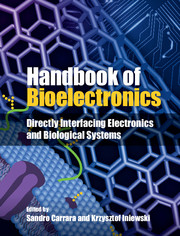Book contents
- Frontmatter
- Contents
- List of Contributors
- 1 What is bioelectronics?
- Part I Electronic components
- Part II Biosensors
- Part III Fuel cells
- Part IV Biomimetic systems
- Part V Bionics
- Part VI Brain interfaces
- 27 Introduction to brain–machine interfaces
- 28 ECG technology for the brain–machine interface
- 29 Reducing the implant footprint: low-area neural recording
- 30 Electrical stimulation
- 31 Biological channel modeling and implantable UWB antenna design for neural recording systems
- 32 Intracranial epilepsy monitoring using wireless neural recording systems
- 33 Low-power building blocks for neural recording systems
- 34 CMOS circuits for intracellular brain–machine interfaces
- Part VII Lab-on-a-chip
- Part VIII Future perspectives
- Index
- References
30 - Electrical stimulation
from Part VI - Brain interfaces
Published online by Cambridge University Press: 05 September 2015
- Frontmatter
- Contents
- List of Contributors
- 1 What is bioelectronics?
- Part I Electronic components
- Part II Biosensors
- Part III Fuel cells
- Part IV Biomimetic systems
- Part V Bionics
- Part VI Brain interfaces
- 27 Introduction to brain–machine interfaces
- 28 ECG technology for the brain–machine interface
- 29 Reducing the implant footprint: low-area neural recording
- 30 Electrical stimulation
- 31 Biological channel modeling and implantable UWB antenna design for neural recording systems
- 32 Intracranial epilepsy monitoring using wireless neural recording systems
- 33 Low-power building blocks for neural recording systems
- 34 CMOS circuits for intracellular brain–machine interfaces
- Part VII Lab-on-a-chip
- Part VIII Future perspectives
- Index
- References
Summary
This chapter explores electrical stimulation of excitable biological entities. It provides a brief history of electrical stimulation, stimulation parameters, theory of electrode interface impedance, and types of stimulation. Focus is on the technology of charge balancing, power losses, voltage compliance, and associated hardware complexities of electrical stimulators. Stimulus artifacts and inductive power delivery are also discussed, and are often used with stimulators for applications in neural prostheses and therapeutics [1, 2].
Introduction
Electrical stimulation is an important and popular method in which injected charges are mainly responsible for excitation or inhibition of neural or motor structures [3–5]. It can be utilized for treatment of diseases and restoration of dysfunctional organs, such as for the brain [6, 7], retina [8, 9], cochlea [10], or peripheral nerve [11]. The electrical stimulation process is accomplished by using conductive electrodes of specific size and shape, which are placed at desired biological sites of interest. Coulombic charge is injected through such electrodes by means of constant current or constant voltage pulses. Charge injection accuracy, power loss minimization, output voltage compliance, and miniaturization are important factors that can enhance practical performance in electronic stimulators [12]. In the following subsections we provide a brief history and introduce technical parameters associated with electrical stimulation.
- Type
- Chapter
- Information
- Handbook of BioelectronicsDirectly Interfacing Electronics and Biological Systems, pp. 365 - 378Publisher: Cambridge University PressPrint publication year: 2015
References
- 1
- Cited by



